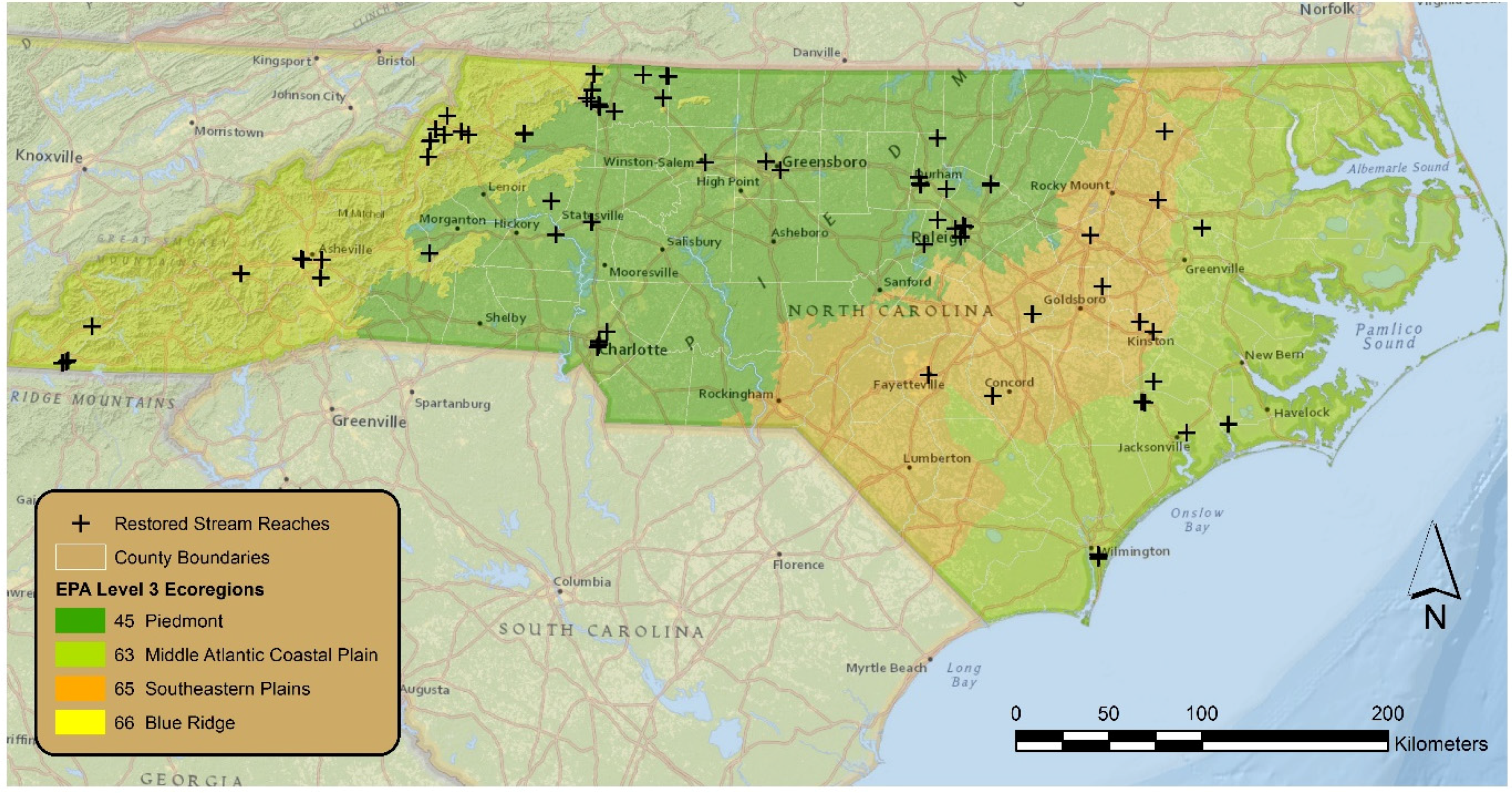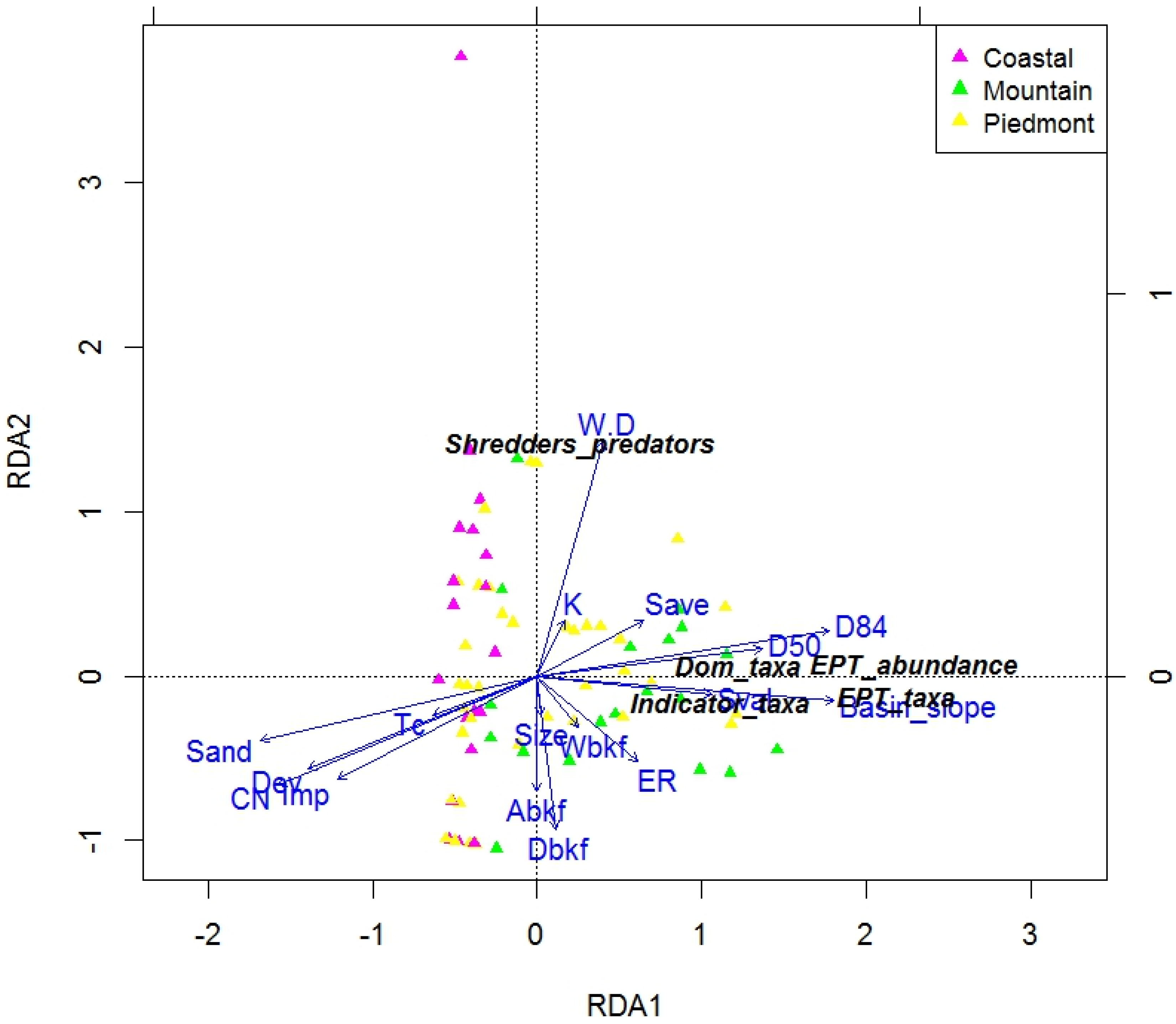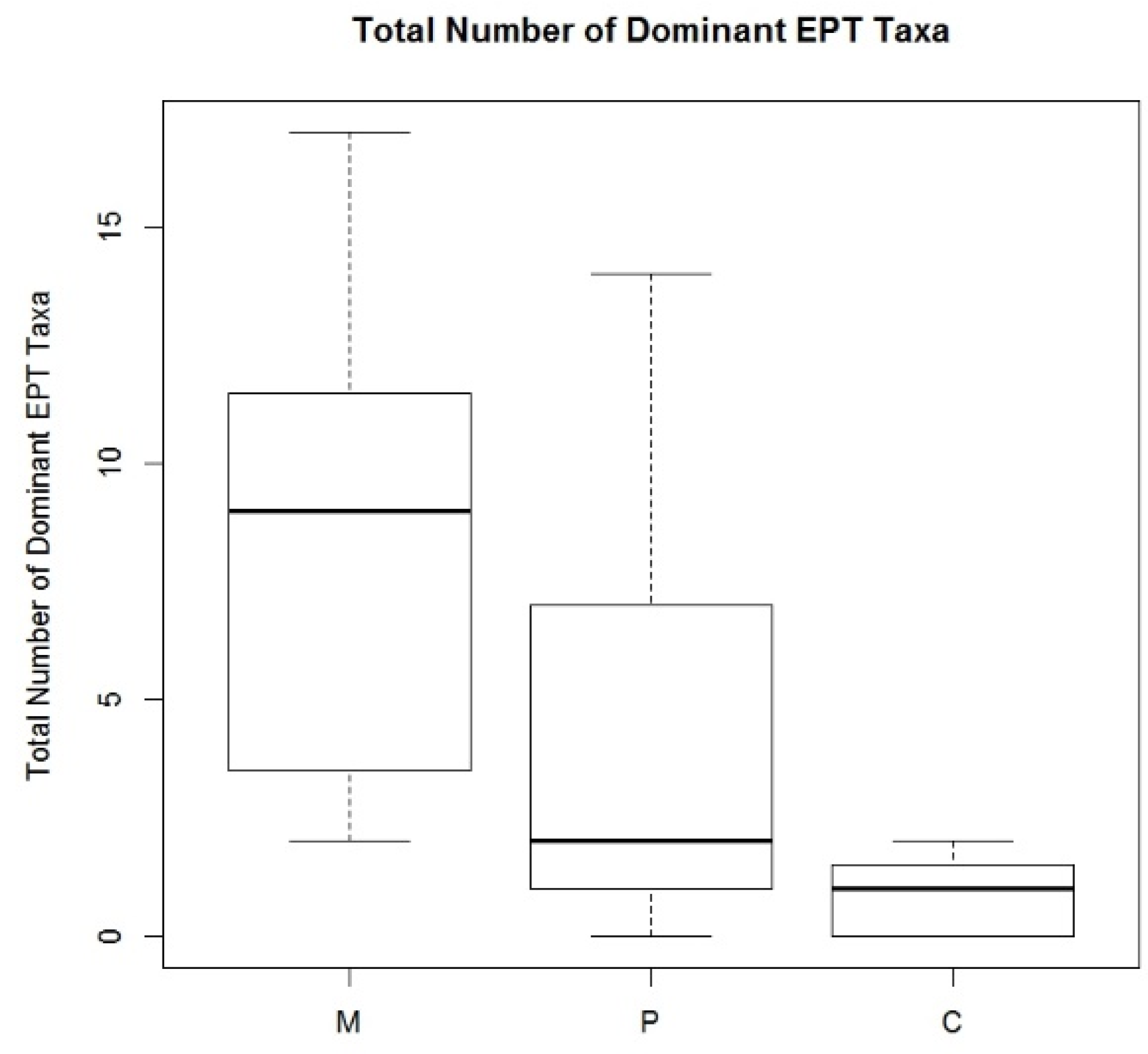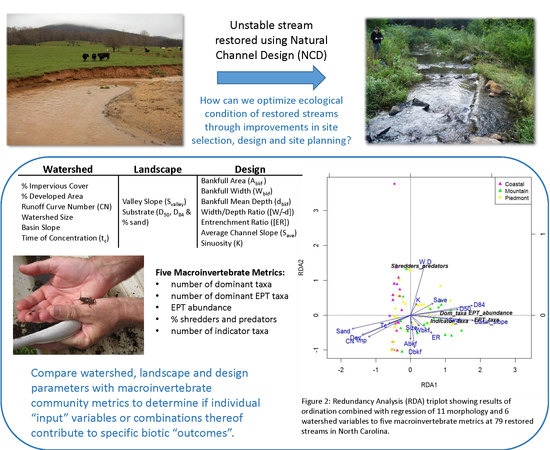1. Introduction
Today, many ecological restoration practitioners restore streams using a natural channel design (NCD) approach. The current analogous approach can largely be attributed to a well-known professional geomorphologist, Dave Rosgen, as the method requires knowledge of his stream classification system [
1] and is underpinned by the fluvial geomorphological elements outlined in his publications and training workshops [
2,
3]. Hey [
4] refers to the “Rosgen Method” as a fluvial geomorphological methodology for designing natural stable channels. He describes the process as an analogue procedure where cross-sectional area and pattern relationships (e.g., sinuosity) are scaled from a natural stable reference stream to determine the restoration design. The practice of NCD as an approach to stream restoration emerged in the southwest United States in 1986, with the first documented project implemented on the East Fork of the San Juan River in southern Colorado [
5]. Since this first project was constructed, stream restoration has spread to most parts of the country and to other areas of the world. Nationally, more than one billion dollars are spent annually on restoration projects [
6], and efforts to return rivers to pre-disturbance conditions, or some close approximation, are becoming popular around the world as well [
7].
NCD is focused on restoring stability or dynamic equilibrium to disturbed streams. Equilibrium has been described as a balance among hydrologic, hydraulic, and sediment factors [
2,
8,
9,
10,
11]. In an attempt to attain equilibrium in the disturbed reach, NCD focuses on rebuilding characteristics found in high quality reference streams that are believed to be linked to equilibrium, including a properly sized bankfull channel, an accessible floodplain (
i.e., regularly flooded) that is of adequate width, meanders, and the presence of bedform habitat and diversity (e.g., riffles, pools). The bankfull stage is associated with the flow that just fills the channel to the top of its banks and at a point where the water begins to overflow onto a floodplain [
12]. A stable stream will have flows that frequently spill out of the bankfull channel onto the floodplain. Hydraulic geometry relationships, or regional curves, relate bankfull stream channel dimensions to watershed drainage area [
13]. Regional curves are commonly used to inform stream designers of stream geometry characteristic of the region in which they are working.
A “guiding image” of a healthy river is often used in stream restoration projects [
7,
14]. Detailed knowledge of the undisturbed condition of an ecosystem is a key planning element of restoration [
15]. Reference ecosystems commonly serve as the “guiding image” for ecological restoration projects. One or more high quality stable reference stream(s) within the same hydrophysiographic region serve as the design template for NCD stream restoration [
16,
17]. Current NCD restoration relies on stable reference channels to obtain morphological variables to apply in the restoration design. Numerous dimension, pattern, and profile measurements are obtained from reference channels. These data are then scaled by calculating dimensionless ratios so they are appropriately sized for the design stream. Dimensionless ratios are determined by dividing each direct measured value from the reference stream by the bankfull width, bankfull mean depth, or average stream slope of the reference channel.
Design procedures for NCD restoration require the designer to select a bankfull channel size (
Abkf) and discharge (
Qbkf), and the ratio of bankfull channel width to mean depth ratio—frequently referred to as the width-to-depth ratio [
W/
d] [
17,
18,
19]. Channel size can be determined from an existing condition survey of the stream that includes identification of field indicators of bankfull stage [
17]. Bankfull width (
Wbkf) is then calculated from the cross-sectional area (
Abkf) and [
W/
d].
Reference reach survey data is also used to calculate dimensionless pattern geometry relationships that are then scaled to the design stream (by multiplying by the design bankfull width). Specifically, pattern ratios are used for scaling radius of curvature, meander belt width, and meander wavelength. A target range of values for each pattern variable is determined and combined with design experience and conditions or limitations of the project site (e.g., valley width, valley slope, and substrate), and is then used for drawing a new or modified stream alignment. These key design decisions and computations combined with the resulting stream alignment produce a channel sinuosity (K) and slope, where sinuosity is a measure of stream length divided by the valley length, and stream slope is the change in elevation of the stream divided by the thalweg length.
Data from undisturbed reference reaches can also be used to influence the selection of the width-to-depth ratio [
W/
d], target sinuosity (
K), and entrenchment ratio (ER). ER is a dimensionless ratio that is proportional to the amount of floodplain available to the stream and is calculated by:
where
Wfpa = width of the flood prone area and
Wbkf is the width of the bankfull channel. Width of the floodprone area (
Wfpa) is measured at the elevation of twice the maximum depth above the thalweg [
1,
19]. Similarly, bedform profile features (e.g., riffle length and slope, pool depth and width) are based on the dimensionless relationships from the undisturbed reference channels. Final adjustments to channel slope and depth are based on sediment transport analyses using equations such as Shields [
20], Andrews [
21], and/or FLOWSED/POWERSED [
22]. It is anticipated that following this design process combined with successful construction and establishment of vegetation will result in channel equilibrium. Little study has been done to determine which, if any, of these design procedures and decisions affect a positive change in the biotic condition of a restored stream.
Numerous factors likely influence the outcome of a restoration project, of which many are predetermined, including the geology, topography, hydrology, history, and landuse of the site, as well as the surrounding watershed conditions. However, site selection is often driven by feasibility alone rather than by potential effectiveness. A critical assessment of where restoration efforts are most needed to meet relevant water quality, ecological, social, and/or mitigation requirements should be combined with careful consideration of the watershed and landscape history and condition when selecting a restoration site [
23].
Watershed condition should be carefully considered when evaluating or proposing biotic goals and objectives for restoration projects as research has linked watershed development and hydrologic factors to stream condition, function, and health since the 1970s. As little as 10% impervious cover within the watershed (e.g., roads, sidewalks, rooftops, parking lots) has been linked to stream degradation, with the severity increasing as impervious cover increases [
24,
25]. Urban development or impervious cover can result in increased peak discharges [
26], channel incision, and subsequent channel enlargement [
27,
28] and associated erosion. Enlargement ratios of 0.7–3.8 were reported in the Piedmont of Pennsylvania [
27] and 2.65 for Piedmont North Carolina streams [
28]. Channel incision leads to less stream-floodplain interaction, reduced spatial habitat heterogeneity [
29], greater temporal instability, reduced hydraulic retention, degradation of water quality, stream channel enlargement, and shifts in the fish community structure [
30,
31].
A study of 10 New Hampshire coastal streams observed a general decline in macroinvertebrate community metrics as the watersheds shifted from a dominant land cover of forest to urban [
32]. In addition, higher concentrations of most water contaminants were associated with higher percent impervious cover. The percent of urban land in the buffer zones just upstream of sampling sites correlated the highest with stream quality variables tested. Water quality and habitat, biological condition, and taxa richness showed a significant decline in the range of 7%–14% impervious cover, as determined by Deacon
et al. [
32], which is consistent with the point of decline reported by others compiled by Schueler [
24]. In contrast, Booth
et al. [
33] found that neither impervious area nor riparian condition alone may predict the biological condition of stream sites located in western Washington State. Booth concluded that biological condition was highly variable with low levels of development, but was consistently poor at high levels of impervious percentage and associated urban cover.
This study compares watershed, landscape, and design parameters (
Table 1) with macroinvertebrate community metrics to determine if individual “input” variables or combinations thereof contribute to specific biotic “outcomes”. From the site selection to the design process it would be beneficial to stream designers, conservationists, and environmental/mitigation policy makers to determine what factors (both controllable and non-controllable) affect the resulting biotic condition of the restored stream. This information may help to optimize performance of restoration efforts through improvements in site selection, stream design, and site planning.
4. Discussion
Principal component regression analysis of 79 restored streams indicated that 11 morphology related stream design and landscape variables were found to be significantly related to four macroinvertebrate metrics, including number of abundant taxa, number of indicator taxa, and number and abundance of EPT taxa. The linear regression revealed that the morphology PCs did not explain a significant portion of the variability in the macroinvertebrate metrics. Further, PCA of a combined matrix of watershed conditions with morphology variables improved correlation when the resulting PCs were linearly regressed in relation to the macroinvertebrate metrics. These results suggest that site selection, including watershed condition, and design procedures and decisions made by the project managers and designers have an influence on the biological outcome of the stream restoration project. Further, this study confirms the influence of watershed condition on macroinvertebrate community metrics that is previously well documented [
32,
36,
54].
Ridge regression of 11 morphology variables was successfully used to predict the number of dominant EPT taxa compared to measured values from field sampling of the 79 restored streams (
R2 = 0.62). The ridge model was improved by adding six watershed variables (
R2 = 0.82). However, the interpretation of the ridge regression model relative to site selection and design was difficult due to both negative and positive weighting of variables with correlation. Therefore, variable reduction using a correlation matrix and interpretation of an RDA triplot resulted in the selection of nine variables to retain for ridge regression. Variables retained included bankfull channel mean width, width-to-depth ratio, entrenchment ratio, sinuosity, valley slope, basin slope, median substrate particle size, time of concentration, and runoff curve number. The reduced model improved interpretation of the results while also providing a reasonable prediction of EPT taxa (
R2 = 0.67). The model indicated that larger (wider) streams in steeper valleys with larger substrate and undeveloped watersheds will have higher numbers of dominant EPT taxa. This result was expected given the extremely low EPT taxa numbers that were found in lower gradient, sand-bed dominated Coastal Plain streams and in urban streams (percent impervious ≥ 10). The increase in channel size (e.g., width) positively affecting macroinvertebrate community metrics has been seen in several regions around the world [
55,
56]. Further, the model results reflect the disparity in EPT taxa and other macroinvertebrates between regions and watershed conditions in North Carolina. These results support findings of no difference in macroinvetebrate communities between urban degraded and restored channels in the Piedmont region of North Carolina [
57]. Rather, macroinvertebrate metrics were best predicted by channel habitat complexity and watershed impervious cover.
The reduced ridge regression model also indicates that larger accessible floodplain widths (higher ER values) correlate with higher EPT taxa values, and, in contrast, high width-to-depth ratios, [
W/
d], and high levels of sinuosity,
K, correlate with lower EPT taxa numbers. Therefore, expanding floodplain area should be a focus of restoration projects, especially when project goals include improving macroinvertebrate diversity. Increasing floodplain connectivity and width is also likely to enhance nutrient removal [
58,
59,
60,
61,
62,
63]. In contrast to entrenchment ratio, increasing sinuosity may not be a primary concern for macroinvertebrate community improvement. Many streams in need of restoration and enhancement occur in restricted corridors where increasing sinuosity is difficult. Doyle
et al. [
64] found a slightly higher, yet significant, increase in sinuosity among streams built for mitigation purposes
versus those for non-mitigation purposes in North Carolina and suggested that this was a result of restoration designers striving to increase the length of the restored stream to maximize mitigation credits, and thus economic benefits, of the project. This study indicates that increasing the floodplain width will afford greater improvements in macroinvertebrate community over sinuosity. However, increasing sinuosity may have a positive effect on nutrient removal similar to increasing floodplain area and access. This may be true especially for streams of less than 10 meters in width, as these channels frequently remove as much as 50% of the nitrogen produced by their watershed, with uptake and removal occurring on submerged sediments and biofilm [
65]. For example, restored sections of Wilson Creek in Kentucky showed improved nutrient uptake and reduced flow velocity when compared to the unrestored reaches [
60]. Therefore increasing sinuosity combined with improving frequency of floodplain access would be appropriate targets for removing nitrogen.
Larger width-to-depth ratio negatively influencing EPT taxa numbers may indicate that wide-shallow streams have an influence on the macroinvertebrate community. However, it should be noted that high EPT abundance was primarily associated with medium sized watersheds of greater than 2.6 to less than 26 square kilometers. Width-to-depth ratio interacts with many other geomorphic parameters (pool depth, velocity, shear stress, substrate size, etc.) making conclusions about this result difficult. The PCR and ridge regression models developed to predict EPT taxa reflect the range of conditions of the 79 restored streams sampled by this study in North Carolina. Further, cross-validation revealed that the ridge model is likely be a good predictor of EPT taxa numbers in other restored streams located in the state. However, these regression models should not be used to predict EPT taxa in other states or regions of the country where the range of variability and the importance of each predictor are likely to differ.
Given the lack of EPT taxa expected to occur in coastal and urban settings regardless of restoration activities, other biological and ecosystem metrics should be considered for evaluating project need, site selection, design, and performance of urban and coastal stream restoration efforts. Strongly considering physical form or morphology of a stream restoration project as a logical objective to assess in addition to habitat and biology, the Ohio Department of Environment and Natural Resources evaluated 51 restored streams using assessment parameters that addressed a variety of characteristics that were measurable, products of design, and deemed necessary for ecological function [
66]. As a result, stream power, channel size, flood frequency, floodplain extent, floodplain connectivity, and sinuosity at the restored streams were compared to benchmarks developed from the literature, modeling, and/or field data collected from non-restored streams in Ohio. Woolsey
et al. [
7] identify 49 indicators designed to assess 13 potential objectives including social, environmental, and economic factors likely relevant to stream restoration. More recently, Starr
et al. [
67] developed a function-based assessment tool for stream restoration that applies a number of existing and new measurement methods and performance standards for use in assessing project need and quantifying functional uplift of restoration efforts. This tool strongly emphasizes watershed hydrology, channel and floodplain hydraulics, geomorphology, and physicochemical parameters as controlling factors in the ultimate biological condition of the restored stream. If the relationships between these factors are not considered, then unrealistic and unachievable goals and objectives and subsequent associated target success metrics will be established for projects.













